ASUSTeK Computer A620BT Bluetooth Pocket PC User Manual manual 1
ASUSTeK Computer Inc Bluetooth Pocket PC manual 1
Contents
- 1. manual 1
- 2. manual 2
- 3. manual 3
- 4. manual 4
manual 1

MyPal A620BT
User’s Manual

ii
Copyright © 2003 ASUSTeK COMPUTER INC. All Rights Reserved.
No part of this manual, including the products and software described in it, may be
reproduced, transmitted, transcribed, stored in a retrieval system, or translated into any
language in any form or by any means, except documentation kept by the purchaser for
backup purposes, without the express written permission of ASUSTeK COMPUTER INC.
(“ASUS”).
Product warranty or service will not be extended if: (1) the product is repaired, modified or
altered, unless such repair, modification of alteration is authorized in writing by ASUS; or (2)
the serial number of the product is defaced or missing.
ASUS PROVIDES THIS MANUAL “AS IS” WITHOUT WARRANTY OF ANY KIND, EITHER
EXPRESS OR IMPLIED, INCLUDING BUT NOT LIMITED TO THE IMPLIED WARRANTIES
OR CONDITIONS OF MERCHANTABILITY OR FITNESS FOR A PARTICULAR PURPOSE.
IN NO EVENT SHALL ASUS, ITS DIRECTORS, OFFICERS, EMPLOYEES OR AGENTS BE
LIABLE FOR ANY INDIRECT, SPECIAL, INCIDENTAL, OR CONSEQUENTIAL DAMAGES
(INCLUDING DAMAGES FOR LOSS OF PROFITS, LOSS OF BUSINESS, LOSS OF USE
OR DATA, INTERRUPTION OF BUSINESS AND THE LIKE), EVEN IF ASUS HAS BEEN
ADVISED OF THE POSSIBILITY OF SUCH DAMAGES ARISING FROM ANY DEFECT OR
ERROR IN THIS MANUAL OR PRODUCT.
SPECIFICATIONS AND INFORMATION CONTAINED IN THIS MANUAL ARE FURNISHED
FOR INFORMATIONAL USE ONLY, AND ARE SUBJECT TO CHANGE AT ANY TIME
WITHOUT NOTICE, AND SHOULD NOT BE CONSTRUED AS A COMMITMENT BY ASUS.
ASUS ASSUMES NO RESPONSIBILITY OR LIABILITY FOR ANY ERRORS OR
INACCURACIES THAT MAY APPEAR IN THIS MANUAL, INCLUDING THE PRODUCTS
AND SOFTWARE DESCRIBED IN IT.
Microsoft, Activesync, Outlook, Pocket Outlook, Windows, and the Windows logo are either
registered trademarks or trademarks of Microsoft Corporation in the United States and/or in
other countries. Microsoft products are licensed to OEMs by Microsoft Lincensing, Inc., a
wholly owned subsidiary of Microsoft Corporation.
E1370
Revised edition V2
July 2003

iii
Contents at a glance
This user’s manual contains the information you need to efficiently use
ASUS
®
MyPal A620BT Pocket PC.
•Chapter 1 - Get started!.............................................................. 1-1
This chapter introduces the ASUS MyPal A620BT Pocket PC, how to
set and power it up, and basic screens that will familiarize you with
its many features.
•Chapter 2 - Learn the basics ..................................................... 2-1
This chapter will teach you the basic functions in MyPal A620BT. You
will learn how to enter, find, and organize information, customize the
device, and use the bundled ASUS utilities.
•Chapter 3 - Microsoft
®
ActiveSync
®
........................................... 3-1
This chapter tells you how to use the Microsoft
®
ActiveSync
®
to
synchronize your device with your desktop computer.
•Chapter 4 - Microsoft
®
Pocket Outlook ..................................... 4-1
This chapter details the procedures for the Microsoft
®
Pocket Outlook
Calendar, Contacts, Tasks, Notes, and Inbox.
•Chapter 5 - Companion programs............................................. 5-1
This chapter includes information on Pocket Word, Pocket Excel,
MSN Messenger, Windows Media Player for Pocket PC, and
Microsoft Reader.
•Chapter 6 - Pocket Internet Explorer ......................................... 6-1
This chapter gives information and procedures on using Pocket
Internet Explorer, Mobile Favorites folder, and AvantGo interactive
service.
•Chapter 7 - Get connected ......................................................... 7-1
This chapter provides the procedures for connecting to the Internet,
and for transferring data using infrared (IR).
•Chapter 8 - Bluetooth™............................................................. 8-1
This chapter provides information on using the Bluetooth feature
built-in the device.
•Appendix - Notices..................................................................... A-1
This part includes the safety notices and regulations.
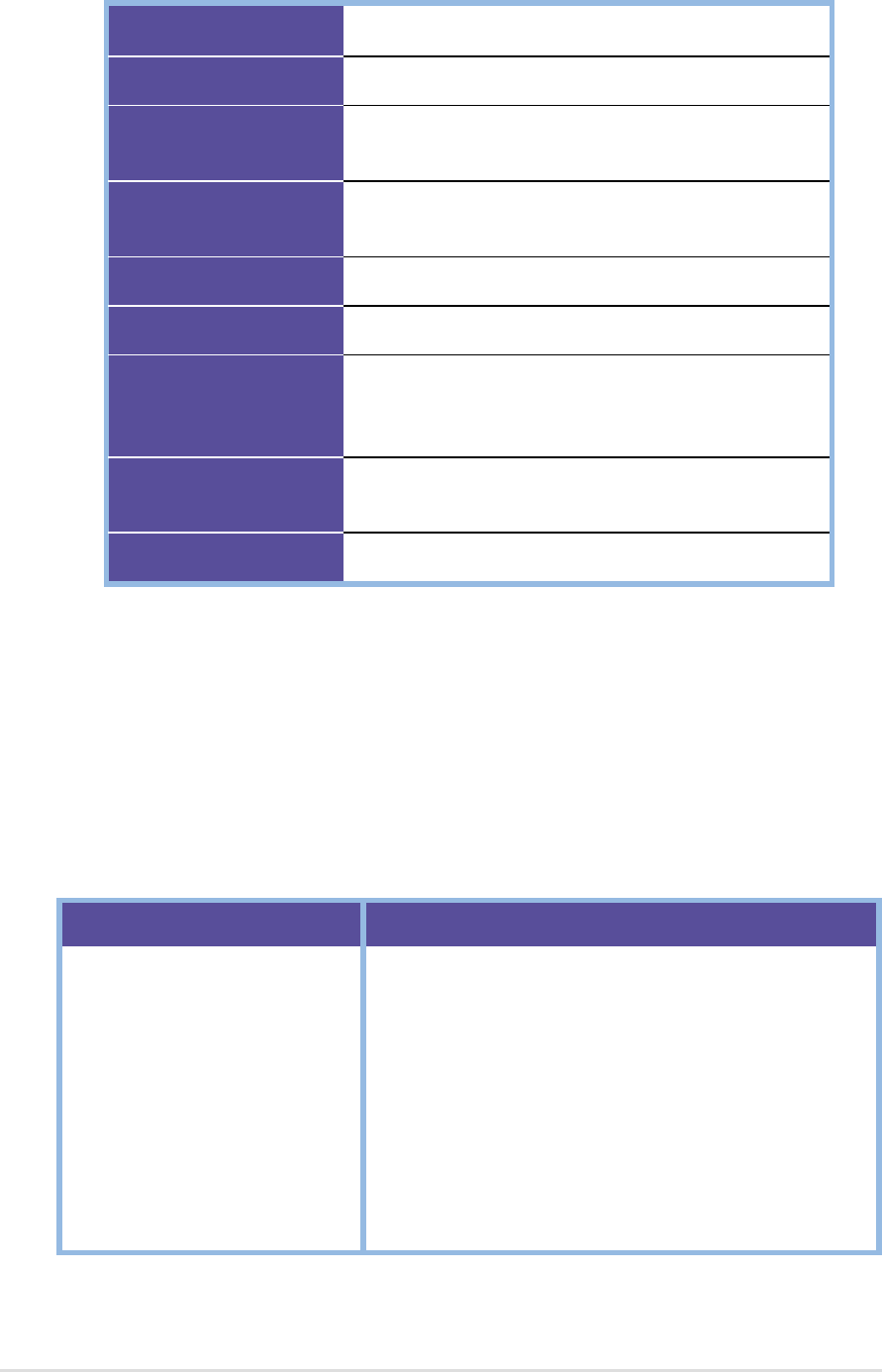
iv
MyPal A620BT specifications
MyPal A620BT package
Your package includes several accessories for the Pocket PC. After
unpacking, check the items against the list below and make sure that they
are in good condition. If any item is missing or damaged, contact your
dealer or retailer immediately.
Processor
Software
Memory
Display
Card slot
Connection
Audio
Size
Weight
Intel PXA255 400 MHz
Microsoft Pocket PC 2003
64MB SDRAM
(55.2 MB user accessible)
64MB Flash ROM
3.5-inch, 240x320 pixels
65,536 colors, Transflective TFT LCD
CompactFlash (CF) Type II slot
Bluetooth, FIR/SIR
Stereo headphone jack
Built-in microphone
Built-in speaker
125 mm x 76.8 mm x 13.3 mm (L x W x H)
4.92 in. x 3.02 in. x 0.52 in. (L x W x H)
Approximately 141g
* English version keyboard. Visit the ASUS website to check the availability of other language version keyboards.
Standard package contents
• ASUS MyPal A620BT
• USB cradle with sync cable
• AC adapter
Input: 100V~240V
Output: 5V 2A 10W
• Stylus
• Microsoft Companion CD
• Bonus CD (optional)
• User’s Manual
• Quick Start Guide
• Warranty card
Optional accessories
• Stylus
• Car charger
• Foldable keyboard*
• Leather handheld case
• Leather waist case
• Traveling USB sync cable
• Cradle with cable
• AC adapter with plug
(UL/CEE/UK/SAA/CCEE)
• GPS mouse
• CF GPS card
• CF wireless LAN card
• CF LAN card
• CF modem card
• CF camera card
• CF VGA card
• CF FM radio card
• CF GPRS card
• Bluetooth dongle
• Bluetooth GPS
• Bluetooth earphone

Get started!
1-1
Chapter 1
Get started!
♦♦
♦♦
♦Introducing MyPal ................................................ 1-2
Front features........................................................................... 1-2
Left side features ..................................................................... 1-3
Top features ............................................................................. 1-4
Bottom features........................................................................ 1-4
Back features ........................................................................... 1-5
The stylus................................................................................. 1-5
The cradle ................................................................................ 1-6
♦♦
♦♦
♦Setting up MyPal................................................... 1-7
Placing on the cradle ............................................................... 1-7
Connecting the AC adapter ...................................................... 1-7
Installing and removing a CF card ........................................... 1-8
Charging the battery .............................................................. 1-10
Activating MyPal .................................................................... 1-10
♦♦
♦♦
♦Basic screens on MyPal......................................1-11
Today screen ...........................................................................1-11
Start menu ............................................................................. 1-12
Command bar ........................................................................ 1-13
Pop-up menus........................................................................ 1-13
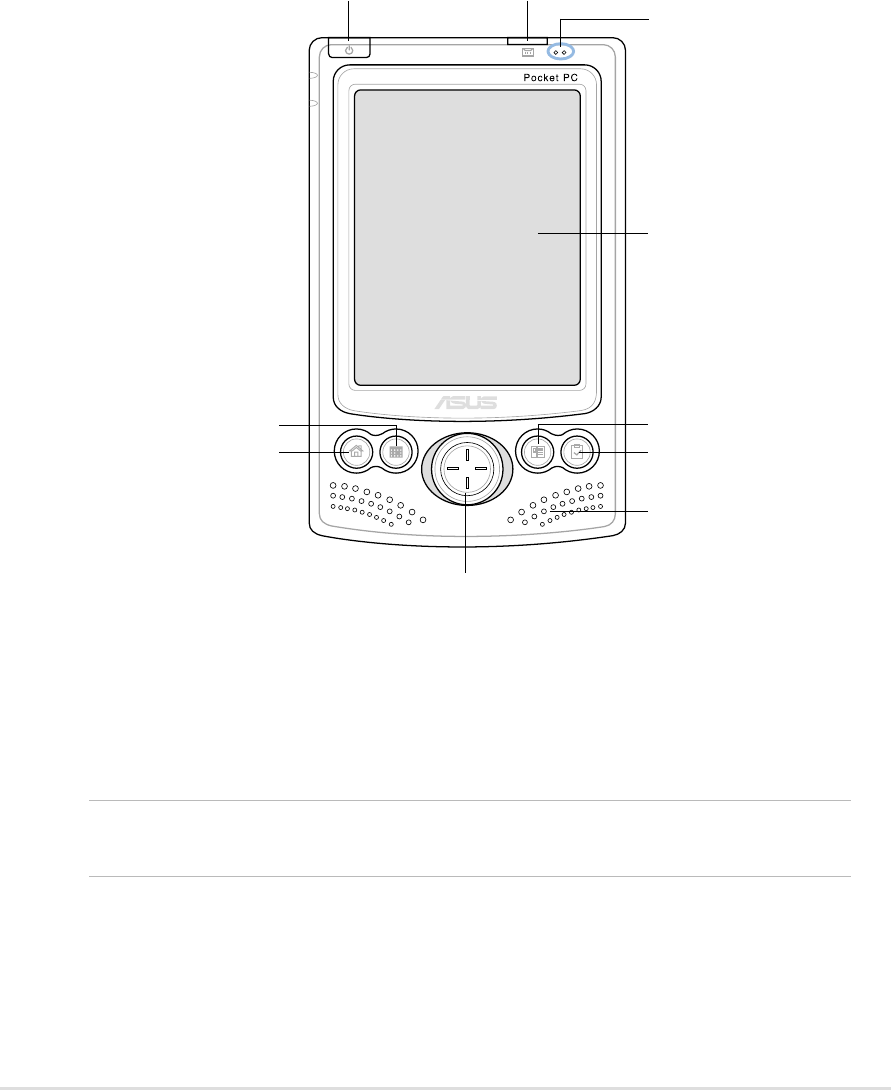
1-2
Chapter 1
Introducing MyPal
The ASUS
®
MyPal A620 is truly a good companion wherever you go.
Powered by a 400MHz Intel
®
PXA255 processor, equipped with 64MB
SDRAM and 64MB Flash ROM, and bundled with the latest Microsoft
Pocket PC 2003 plus a host of useful utilities, you have everything you
need in your pocket!
Front features
•Power/Backlight button - turns the device power on or off if you press
the button quickly. Pressing and holding the button for a few seconds
turns the backlight on or off. Turning off the backlight saves battery
power.
NOTE Press this button and the Tasks button simultaneously if you
wish to launch the Align Screen function.
•Record/Notes button - allows you to record sounds and save them as
files if you press and hold the button, or launches the Notes program
when pressed once.
•Built-in microphone - magnifies your sound recording.
LCD touch screen
Navigation button
Tasks button
Contacts button
ASUS Launcher button
Calendar button
Speaker
Power button/
Backlight button Record button/
Notes button
Built-in microphone
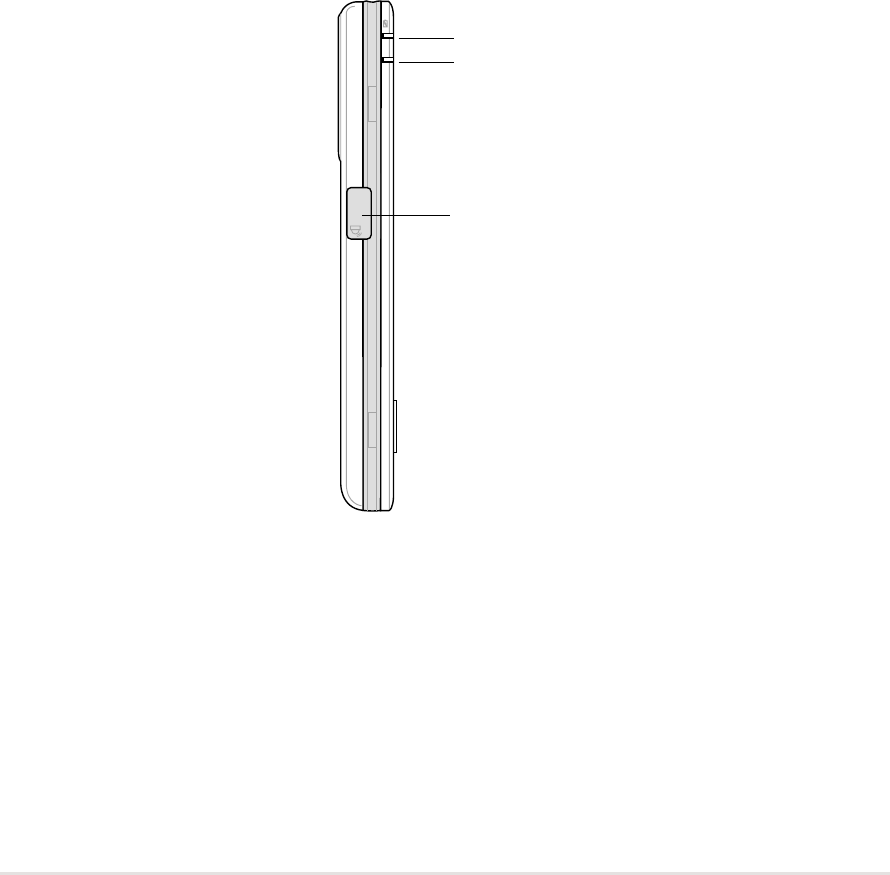
Get started!
1-3
Left side features
•Charging status LED - lights up orange when the battery is charging;
lights up green when the battery is fully charged.
•Dual-function LED
Bluetooth LED (blue) - blinks blue when Bluetooth is ON;
does not light up when Bluetooth is OFF.
System notification LED (red) - blinks red to notify you of a
scheduled event
•Infrared (IR) port - allows you to copy or send data to another device
with an IR port.
•LCD touch screen - allows you to enter, read, send, receive, or edit data
by tapping on it. The screen lumination is increased or decreased by
changing the backlight settings.
•ASUS Launcher, Calendar, Tasks, and Contacts buttons - allow you
quick access to commonly used programs.
•Navigation button - functions like the four arrow keys and the Enter key
on a keyboard. This multifunction button allows you to:
- move through the program icons, folders, or files in a menu by
scrolling up or down
- launch a selected program, list folder contents, or open a file by
pressing the center of the button
•Speaker - allows you to hear alarms and other sound outputs from the
device.
Charging status LED
Bluetooth LED (blue);
System notification LED (red)
Infrared (IR) port
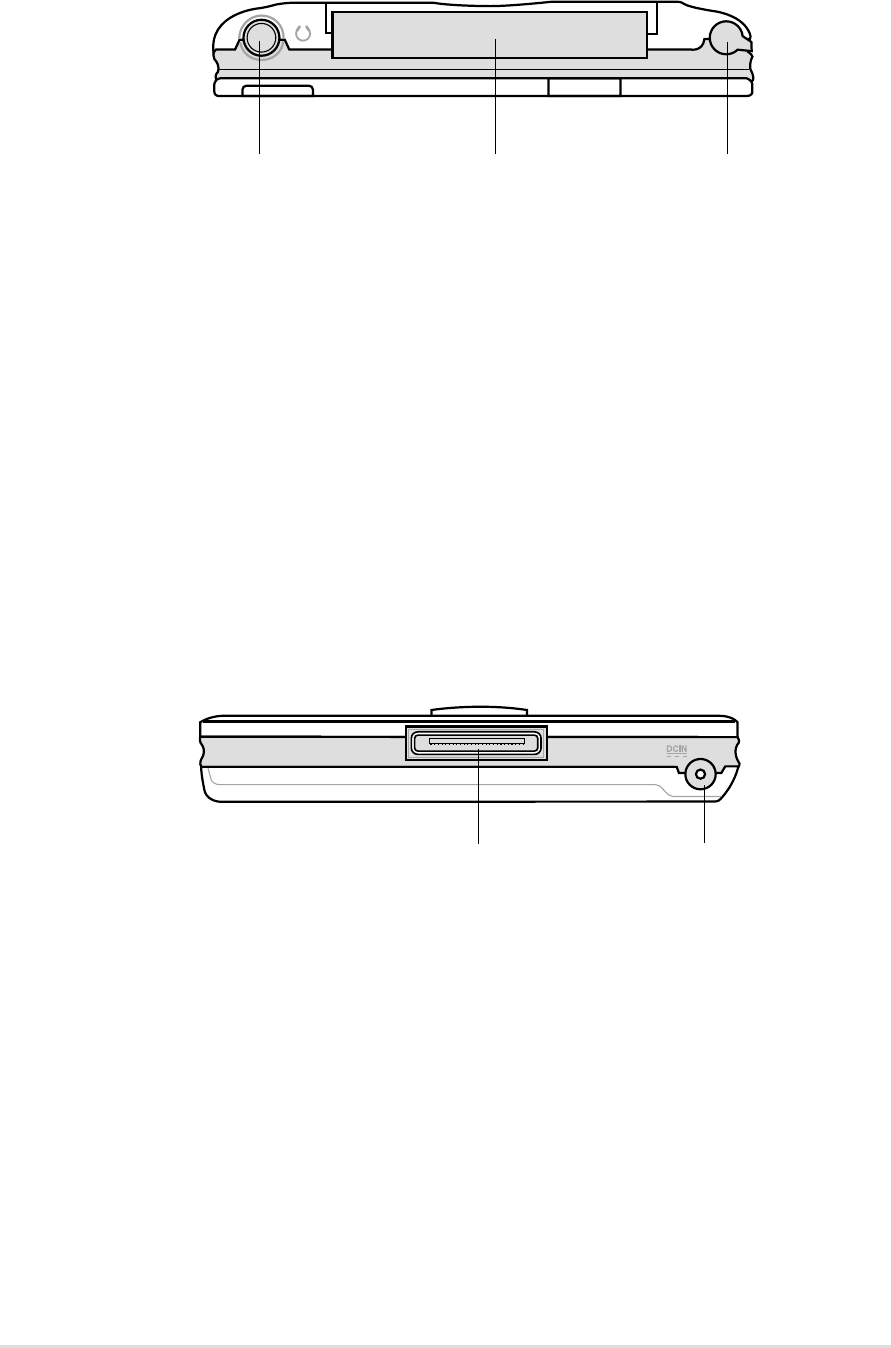
1-4
Chapter 1
Top features
Bottom features
•Headphone jack - connects a headphone.
•CF card slot - accommodates a CompactFlash (CF) card. See list of
supported CF cards on page iv.
•Stylus - used for tapping or writing on the LCD touch screen. Slide out
the stylus from its compartment. Refer to the description of the stylus on
the next page.
•Cradle connector / Sync cable connector - connects to the 26-pin
female connector on the cradle. If you are not using the cradle, connect
the 26-pin USB sync cable directly to this connector to synchronize your
device with your computer.
•Power connector - connects the AC adapter cable. Use this connector if
you wish to use AC power without the cradle.
Cradle connector /
Sync cable connector Power connector
Stylus
CF card slot
Headphone jack
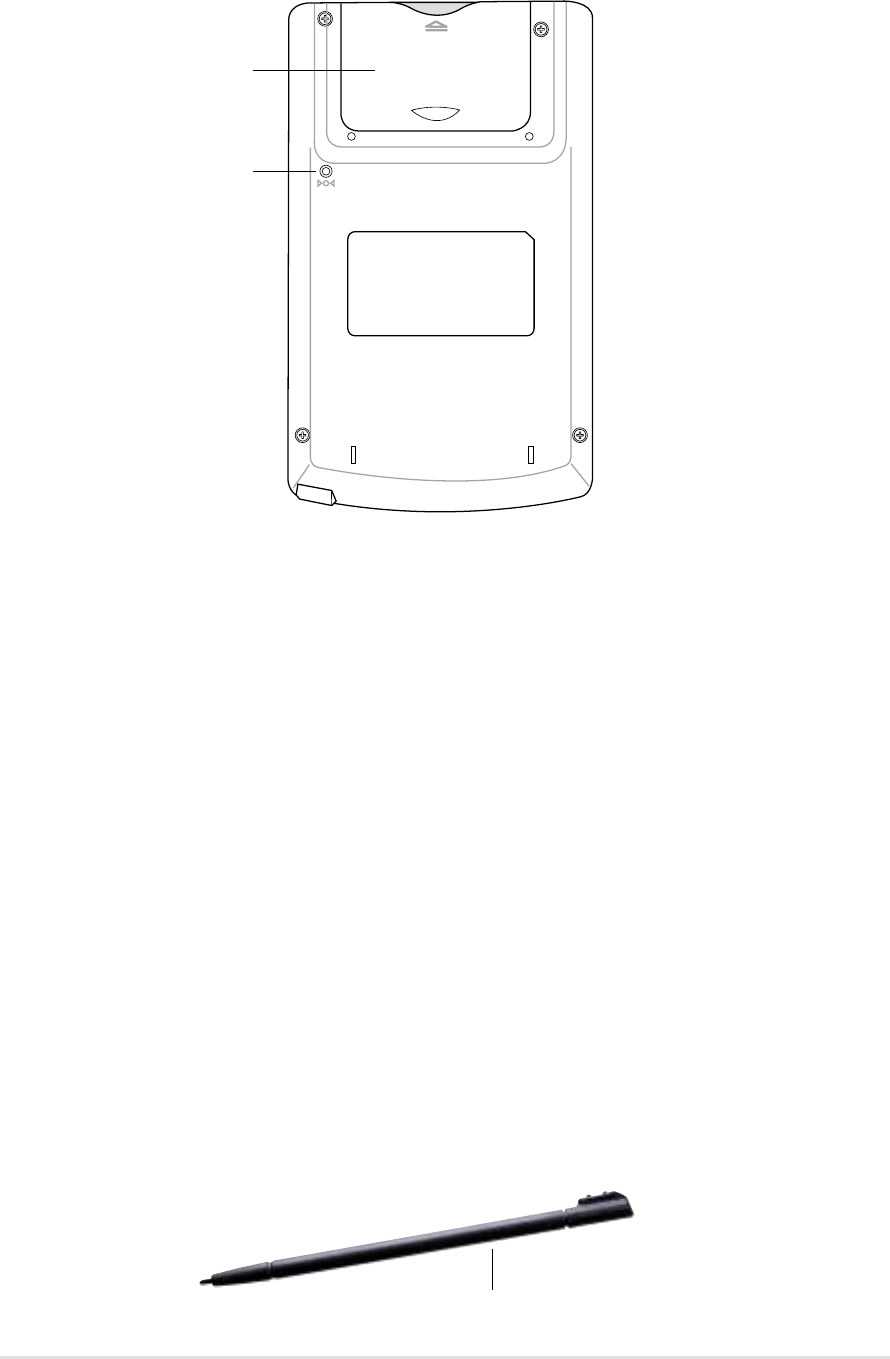
Get started!
1-5
•Reset switch - allows you to perform a soft reset in case the device
malfunctions, or when an application hangs. Press the tip of the stylus on
the switch to reset the system.
•CF card slot cover - protects the slot connector and the CF card.
Back features
The stylus
The stylus functions on a Pocket PC the same way a mouse functions on
a standard PC. Use the stylus to tap or drag on the LCD touch screen to
open programs or execute commands.
•Tap. Touch the screen once with the stylus to open programs and select
options.
•Drag. Hold the stylus on the screen and drag across the screen to select
text and images. Drag in a list to select multiple items.
•Tap and hold. Tap and hold the stylus on an item to see a list of actions
available for that item. On the displayed pop-up menu, tap the action that
you want to perform.
Stylus
Reset switch
CF card slot cover
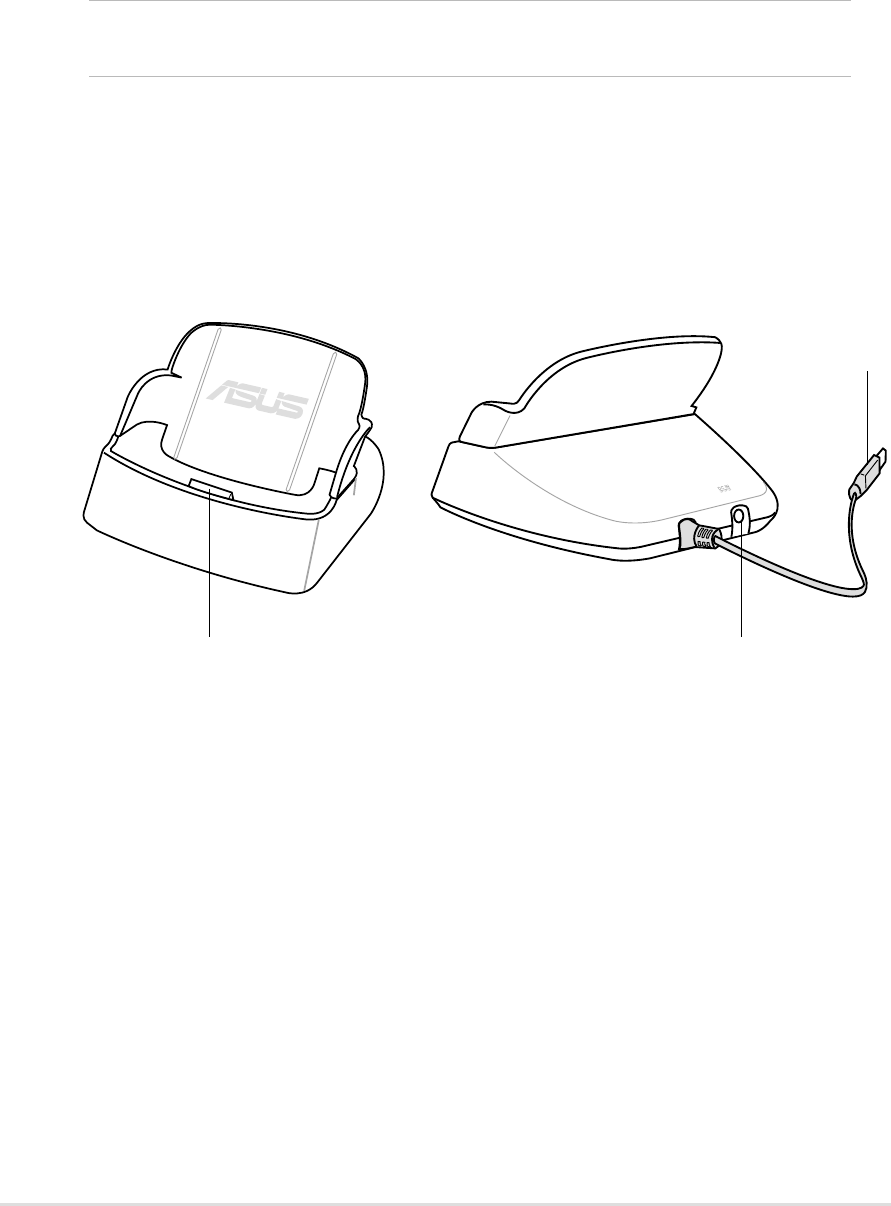
1-6
Chapter 1
The cradle
The cradle has three connectors.
•Device connector - holds the device in place. This is a 26-pin connector
that matches the connector on the bottom of the device.
•USB connector - synchronizes the device with your PC.
NOTE The USB cable/connector is not detachable from the back of
the cradle.
•Power connector - connects the bundled AC adapter. This connector is
located at the back side of the cradle.
Device connector
USB connector
Power connector
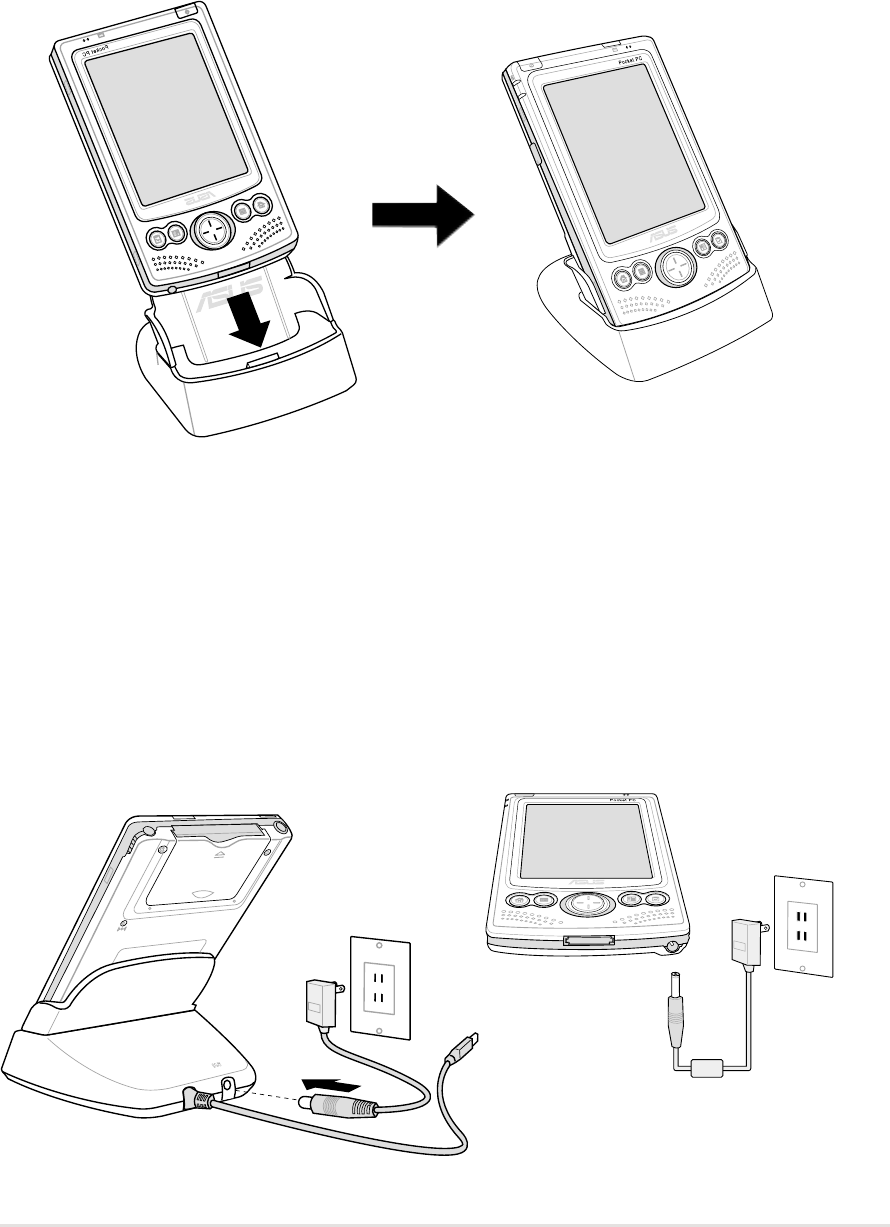
Get started!
1-7
Setting up MyPal
Placing on the cradle
Position the device on the cradle as shown. Match the connectors and
carefully insert the device until it fits in place.
Connecting the AC adapter
•Connect the AC adapter cable to the connector at the back of the cradle.
Connect the power plug to a grounded wall socket. See Figure 1.
•If you are not using the cradle, connect the AC adapter cable directly to
the power connector at the bottom of the device. Connect the power plug
to a grounded wall socket. See Figure 2.
Figure 1 Figure 2
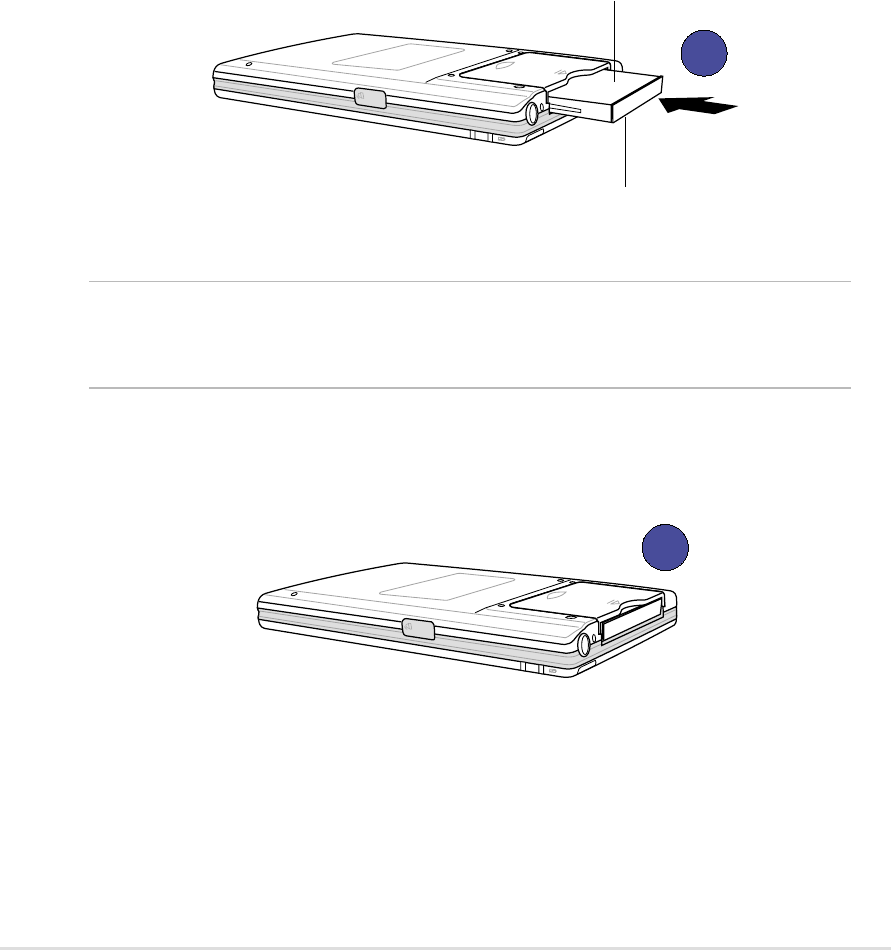
1-8
Chapter 1
Installing and removing a CF card
The CF card slot on your device supports several types of CF card. Refer
to the list of supported cards under “Optional Accessories” on page iv of
this manual.
Install a CF card for additional storage, or if you wish to use the ASUS
backup features.
To install a CF card:
1. Locate the card side with the 50-pin female connector and insert into
the slot. The label side (usually the side with the card manufacturer’s
name) face down, and the bar code/serial number side face up.
NOTE A CF card fits only in one orientation, and slides smoothly into
the slot if inserted correctly. DO NOT force the CF card into
the slot!
2. Push the card all the way into the slot until it fits completely. If properly
installed, the CF card edge aligns with the top edge of the device.
1
Bar code/Serial number side
Label side/Manufacturer’s name
2
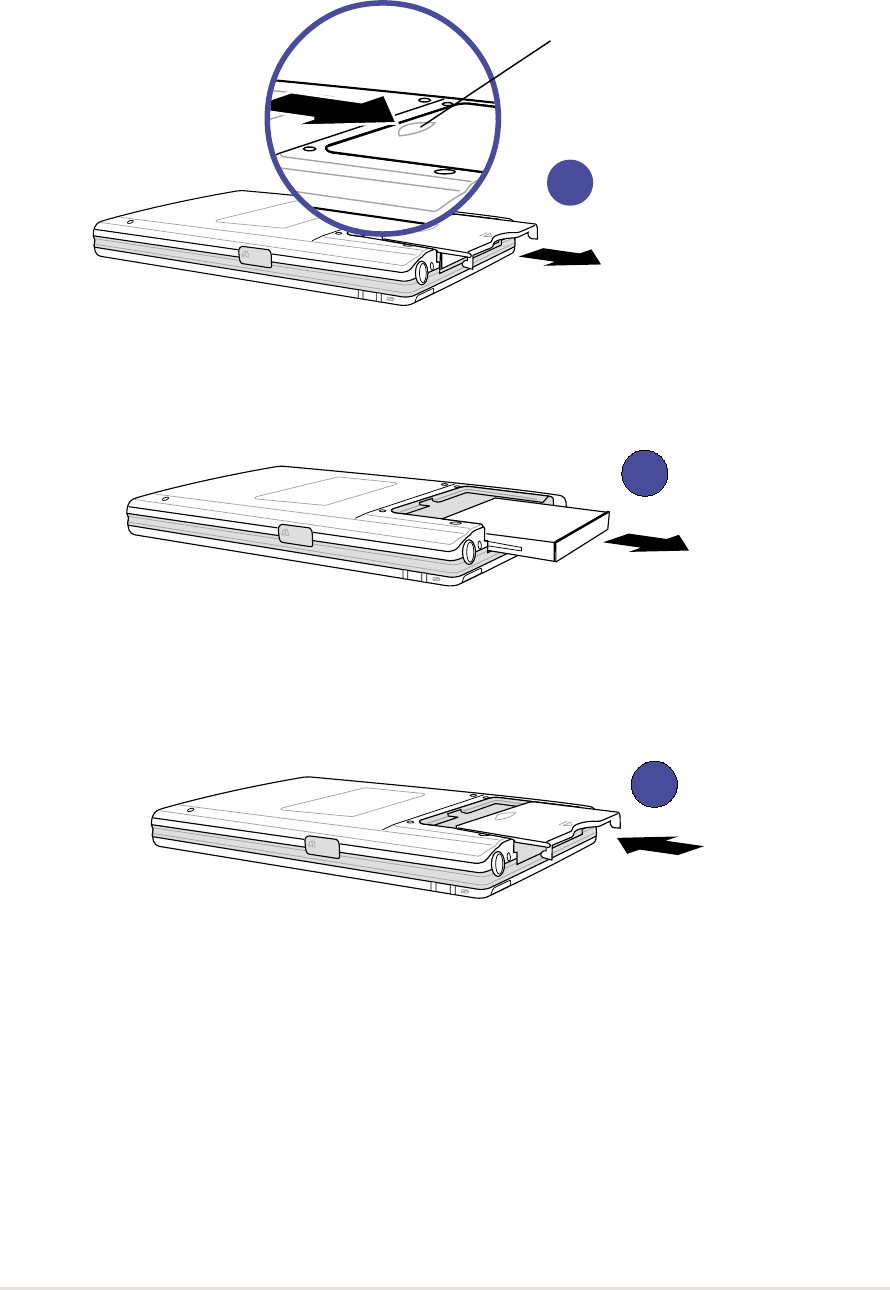
Get started!
1-9
To remove a CF card:
1. Remove the CF card slot cover by pushing on the dent on the surface,
and sliding the cover outward.
2. Slide out the CF card.
3. Replace the cover back into the slot.
Dent on the cover surface
1
2
3
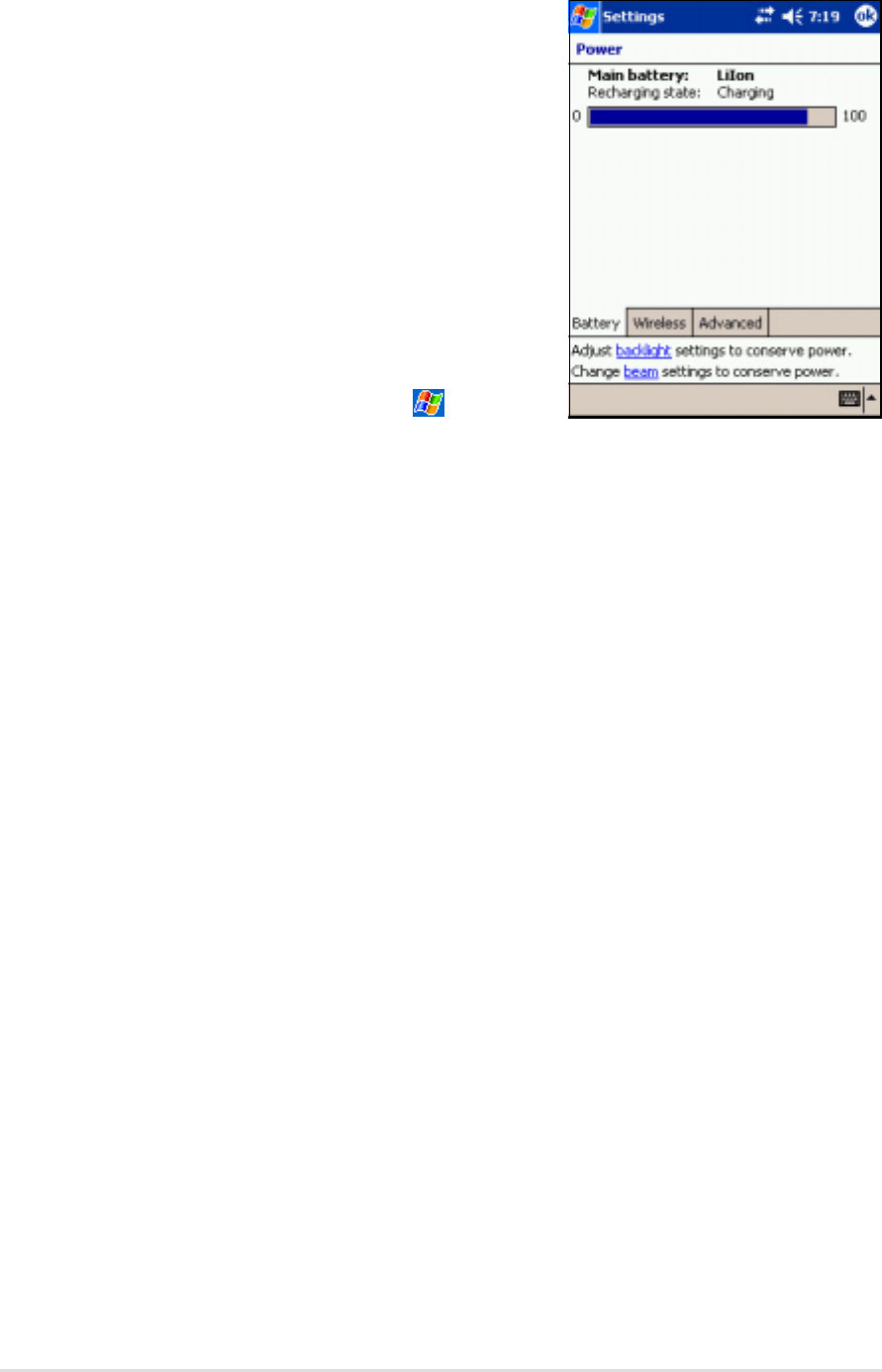
1-10
Chapter 1
Charging the battery
Your device includes a rechargeable Lithium
Ion battery. You must charge the battery
before using the device the first time. The
battery starts charging as soon as you
connect the AC adapter to a power source.
Use the AC adapter to plug your device to a
power source whenever possible, especially
when you are using a modem or other
peripherals, using the device backlight,
connecting to a PC, or letting notification
light flash for extended time periods.
To display the power status, tap ,
Settings, System tab, and the Power icon.
Activating MyPal
It is important that you properly calibrate and activate your device before
using it. This process ensures accurate positioning when entering text and
selecting menus.
Follow these steps to calibrate and activate MyPal.
1. Press the power button.
2. Use the stylus to tap the LCD touch screen to start the calibration and
activation.
3. At the prompt to align the screen, tap the center of the cross whenever
the travelling cross stops on the screen. You may have to do this step
several times to properly calibrate.
4. When done with the screen calibration, follow the screen instructions to
complete the activation.
•at the “Stylus” screen, tap Next to continue.
•at the “Pop-up menus” screens, perform the indicated operations.
•at the “Congratulations” screen, tap Next to continue.
•at the “Location” screen, select your time zone and tap Next to
continue.
•at the “Completion” screen, tap the screen to continue.
5. When the Today screen appears, MyPal is ready to use. Proceed to
the next section for information on the basic screens on your device.
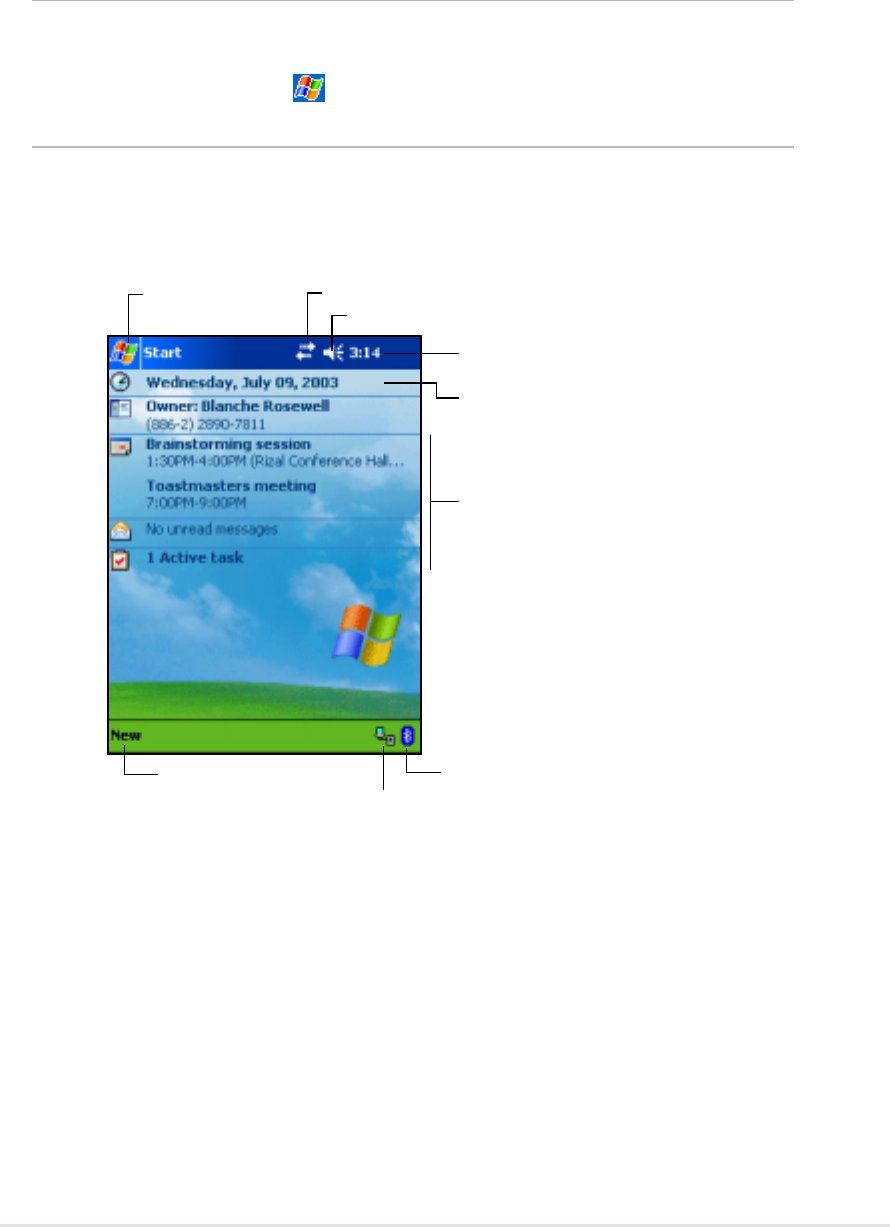
Get started!
1-11
Basic screens on MyPal
Today screen
Normally, the Today screen appears when you turn on your device for the
first time each day.
NOTE When the device is already on and the screen displays
another program, you can display the Today screen by
tapping the icon. Then from the Navigation bar, tap
Today.
As shown in the sample below, the Today screen lets you see at a glance
the summary of the important information for the day.
From the Today screen, tap any of the listed items with the stylus to
display the details. See “Chapter 2: Learn the basics” to learn how to
modify the current tasks or activities, or to add new items or information.
Tap to switch
to a program
Tap to set up or change network or modem connections
Tap to change volume or mute all sounds
Tap to display the date, time,
and your next appointment
Tap to change the date and time
Your day at a glance
Tap to display the Bluetooth menuTap to create a new item
Tap to view PC connection status
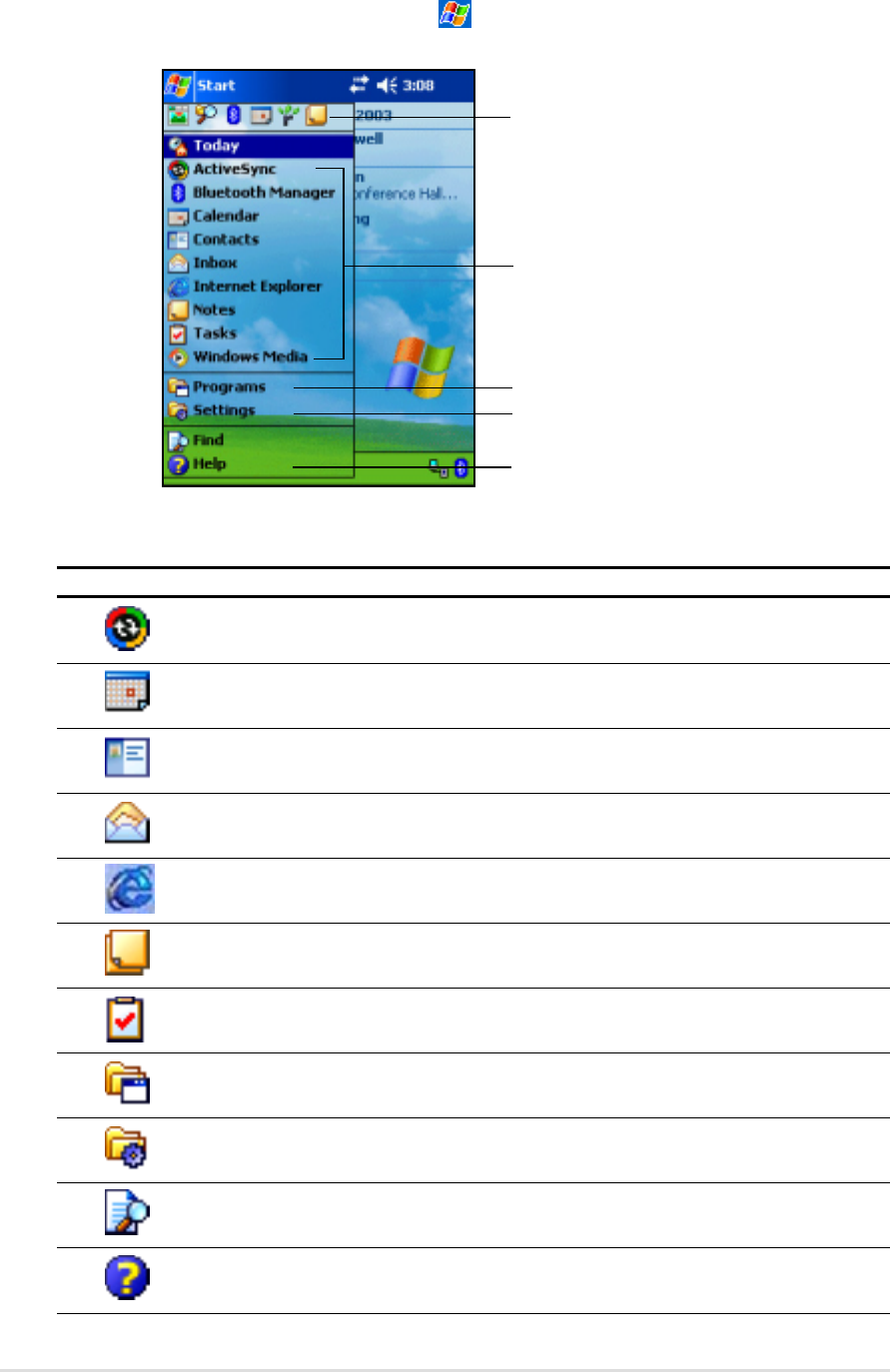
1-12
Chapter 1
Start menu
From the Start menu, you can select programs, settings, and Help topics.
To display the Start menu, tap the icon from the top of the screen.
Icon Program Description
ActiveSync Synchronize information between your
device and your desktop computer.
Calendar Keep track of your appointments and create
meeting requests.
Contacts Keep track of your friends and colleagues.
Inbox Send and receive e-mail messages.
Internet Explorer Browse Web and WAP sites, and download
new programs and files from the Internet.
Notes Create handwritten or typed notes, drawings,
and recordings.
Tasks Keep track of your tasks.
Programs Tap to see additional programs installed in
your device.
Settings Tap to see items that you can customize or
adjust to your preference.
Find Tap to find data in your device.
Help Tap to see the Help contents.
Tap to open a recently used program
Tap to open a program
Tap to open the Programs menu
Tap to open the Settings menu
Tap to display the Help topics
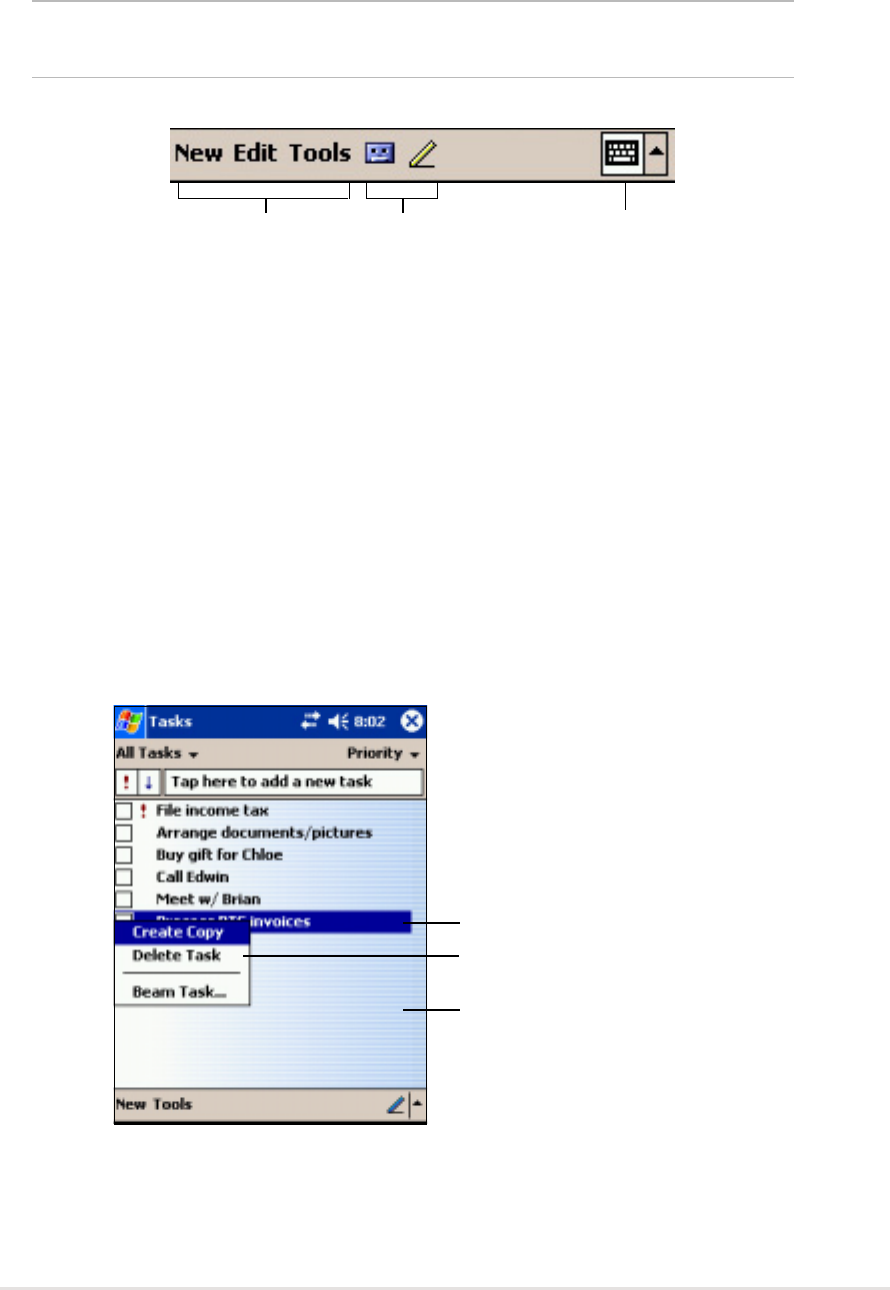
Get started!
1-13
Command bar
At the bottom of the screen is the Command bar. You can use the menus
and buttons on the Command bar to perform tasks in programs.
NOTE The menus and buttons vary depending on the programs you
are using.
Tap to select menu
commands Tap to select
button commands Tap to display
the input panel
Pop-up menus
With the pop-up menus, you can easily choose an action for an item.
For example, you can use the pop-up menu in Tasks to delete, copy, or
beam a task. The actions in the pop-up menus vary from program to
program. To access a pop-up menu, tap and hold the stylus on the item
that you wish to perform action on. When the menu appears, lift the stylus,
and tap the action that you want to execute. To close the pop-up menu
without performing an action, tap anywhere outside the menu.
Tap and hold until the pop-up menu appears
Tap the action that you wish to perform
Tap outside the pop-up menu to close it
without performing an action
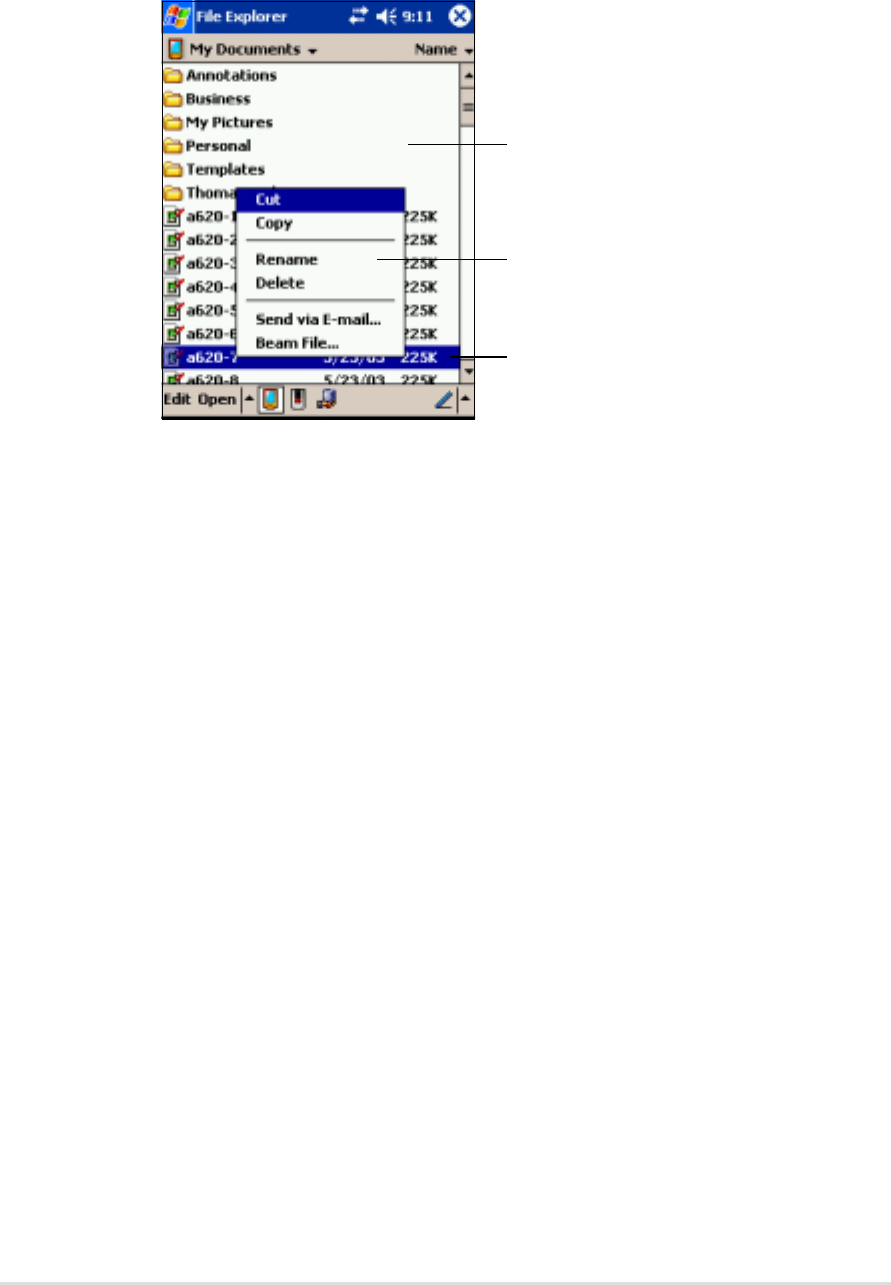
1-14
Chapter 1
Tap and hold until the pop-up menu appears
Tap the action that you wish to perform
Tap outside the pop-up menu to close it
without performing an action
The pop-up menus are also available in most other programs in your
device. The pop-up menu items vary depending on the program or
application. For example, the File Explorer pop-up menu includes more
items than in Tasks.